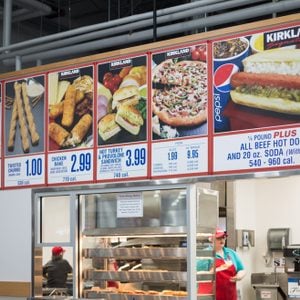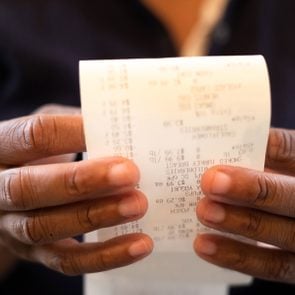This Is the Latest Grocery Store Staple to Soar in Price—And It Could Wreck Your End-of-Summer Barbecue
My favorite part of the summer season? Inviting the neighbors over, firing up the grill and having a good old-fashioned cookout, complete with burgers and brats, homemade ice cream and maybe even a watermelon seed–spitting contest. But this summer, when shopping for items to throw on the grill, I’ve noticed my money doesn’t stretch as far as it used to—and I’m not alone. In fact, according to a recent report, prices for some of the biggest backyard barbecue staples are skyrocketing across the country.
What’s a girl to do? Cancel the cookout? Nope! Google “how to make carrot hot dogs”? Absolutely not. Read on to find out which barbecue favorite is going to cost you a lot more this summer—and how to host your next get-together without going broke.
Get Reader’s Digest’s Read Up newsletter for more food news, money-saving tips, humor, travel, tech and fun facts all week long.
Which barbecue item is skyrocketing in price?

It’s sad news for hamburger lovers: Beef prices have risen sharply in recent months. And this affects all sorts of meat, from ground chuck to filet mignon.
Here’s a little cost comparison for you: One pound of ground beef chuck costs, on average, $6.12, compared to $5.36 a year ago. That’s a whopping 12% increase, according to the U.S. Bureau of Labor Statistics. Seventy-six cents per pound may not seem like a huge hike—until you want to invite your friends, neighbors and cousins show up to that barbecue. Then it starts adding up quickly. And that’s just for the hamburger meat, before you start factoring in the price increases from inflation and tariffs.
As for steaks, the average cost rose 8% overall to $11.49 per pound, which is close to $1 extra per pound. That cost, of course, only goes up depending on the quality of the meat. Ouch!
Why is the cost of meat rising?
There are three major factors contributing to the high cost of beef—and potentially raining on your summer barbecue plans, according to Gabrielle Marie Yap, senior editor of Carnivore Style.
Cattle-feed costs
Yep, those cows have to eat too, and that’s not as affordable as it used to be, thanks to droughts driving up the price of their food. “Feed costs jumped 87% over the past two years as corn and soy prices soared, making cattle expensive to raise,” Yap says. In fact, ranchers now spend nearly $800 more per cow annually just to keep them fed, according to Jon Morgan, a supply-chain expert and the co-founder of Venture Smarter. That cost ends up getting bumped down the road—to you, the consumer.
COVID-related closures
During the pandemic, when stay-at-home orders were in effect and supply-chain issues left us without toilet paper, the beef industry also suffered. Many plants had to close—at least temporarily—to slow the spread of the virus, and the ones that stayed open were often running short on staff due to sick workers. Though it’s been five years since the height of COVID, “processing plants still run 12% below pre-2020 capacity,” says Yap. The recovery has been slow and is affecting how much beef can be processed and how quickly.
Less cattle
COVID isn’t the only illness meddling with meat. A contagious pest called the screwworm fly has been affecting cattle in Mexico, causing U.S. government officials to put a hold on importing beef from below the border. While only 4% of American meat comes from Mexico, it’s 4% we couldn’t afford to lose. Thanks to the high cost of cattle feed, U.S. ranchers have been forced to sell off breeding stock in recent years—which means we actually have fewer beef cattle in the U.S. now than we did in the 1950s, despite having twice the population, says Morgan.
Translation: Less beef in the marketplace drives up the price, thanks to supply and demand.
Is there an end in sight?
Unfortunately, postponing your end-of-summer barbecue to September won’t help you save money. Even if droughts ease and feed costs stabilize, enabling ranchers to afford more cattle, it takes up to two years for those cows to mature and be ready to process, says Morgan.
Plus, we haven’t yet seen the effects of President Donald Trump’s tariffs on the global beef industry. But considering the U.S. imports more than 4 billion pounds of beef every year from places like Australia and New Zealand, which currently have a 10% tariff, and Brazil, where Trump is threatening a whopping 50% tariff, this could definitely drive prices even higher.
What can you do to minimize costs?
Instead of canceling your cookout, try these tips to cut down on costs—without cutting down on flavor.
- Buy in bulk. Shopping at a wholesale big-box store like Costco or Sam’s Club can help you save money on meat. If you don’t have one near you, you can also buy whole briskets or chuck roasts during sales at your local grocery store and portion them yourself. “A $45 whole brisket yields 12 pounds of meat versus paying $8 per pound for pre-cut portions,” says Yap.
- Search for deals by date. Retailers often slash prices to move meat inventory as it nears its expiration date. Take the opportunity to stock up during these sales to save.
- Get creative. “Ground turkey mixed with 20% ground bacon creates amazing burger patties at half the cost of ground chuck,” says Yap.
- Just add veggies. Kabobs aren’t only great for the grill—they’re also a great way to use meat sparingly and still have a filling meal. Plus, they always look fancy!
- Choose chicken over beef. We know, we know—chicken is not beef. But it’s still a good option, and it won’t hurt your wallet as much! Chicken remains relatively stable, price-wise, says Morgan, and “buying whole chickens for $1.20 per pound and breaking them down saves about 60% compared to precut pieces.”
RELATED:
- Here’s Why You Should Skip Precut Fruit Trays at Costco
- The Newest Costco Dessert Is a Must for Your Next Barbecue
- Here’s the Only Place You Should Store Your Ketchup
About the experts
|
Why trust us
At Reader’s Digest, we’re committed to producing high-quality content by writers with expertise and experience in their field in consultation with relevant, qualified experts. We rely on reputable primary sources, including government and professional organizations and academic institutions as well as our writers’ personal experiences where appropriate. We verify all facts and data, back them with credible sourcing and revisit them over time to ensure they remain accurate and up to date. Read more about our team, our contributors and our editorial policies.
Sources:
- Gabrielle Marie Yap, senior editor of Carnivore Style; interviewed, August 2025
- Jon Morgan, co-founder of Venture Smarter; interviewed, August 2025
- AP News: “Beef Prices Have Soared in the U.S.—and Not Just During Grilling Season”
The post This Is the Latest Grocery Store Staple to Soar in Price—And It Could Wreck Your End-of-Summer Barbecue appeared first on Reader's Digest.
from Reader's Digest https://ift.tt/4p5rVAG



Comments
Post a Comment